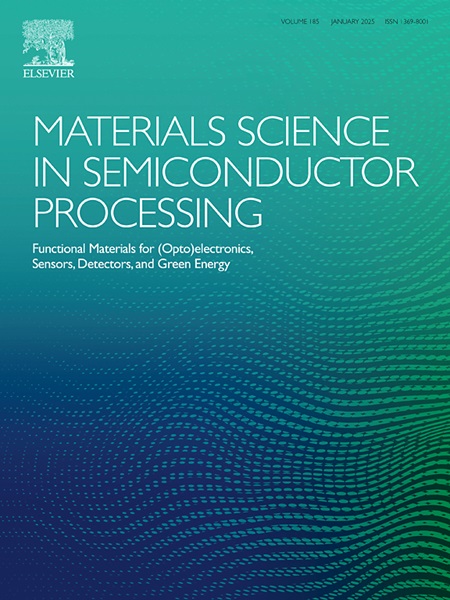皱褶PDMS/MXene复合材料:高效摩擦电纳米发电机的途径
IF 4.6
3区 工程技术
Q2 ENGINEERING, ELECTRICAL & ELECTRONIC
引用次数: 0
摘要
对可持续和绿色能源收集技术的需求不断增加,导致摩擦纳米发电机(TENGs)技术取得了重大进展。然而,传统的teng具有限制其实际应用的缺点,例如低功率输出、表面接触不良和限制电荷产生。摩擦电层表面固有的光滑性降低了摩擦电层的有效接触面积,导致摩擦电层的性能较差。为了克服这一挑战,提高电荷转移和TENG性能,研究人员已经探索了表面工程策略。在目前的工作中,我们提出了一种基于皱褶PDMS/MXene复合材料的TENG,其中在表面引入微结构皱褶有效地增强了接触电气化和TENG性能。本文采用简单的砂纸实现了摩擦电层的表面工程。对起皱和无起皱的PDMS/MXene复合材料进行了对比分析,发现起皱结构显著地放大了摩擦电输出。优化后的器件在PDMS中加入6 wt%的MXene,实现了令人惊叹的开路电压约790 V和短路电流140 μA,分别比未起皱的纯PDMS的电压和电流高3.2倍和7倍。此外,在最佳负载电阻为5 MΩ时,峰值功率密度达到17.10 W/m2,证明了其高效能量转换的能力。最后,将制备的TENG用于LED和LED灯的供电,并研究了其在自供电称重机中的应用。本文章由计算机程序翻译,如有差异,请以英文原文为准。

Wrinkled PDMS/MXene composites: A pathway to high-efficiency triboelectric nanogenerators
The increased demand for sustainable and green energy harvesting technologies has led to significant progress in triboelectric nanogenerators (TENGs) technology. However, conventional TENGs have drawbacks that limit their practical use, such as low power output, poor surface contact, and restricted charge production. The majority of problems come from the triboelectric layers' intrinsic smoothness of the surfaces, which lowers the effective contact area, resulting in poor performance of the TENGs. Surface engineering strategies have been explored to overcome this challenge and enhance charge transfer and TENG performance. In the present work, we present a wrinkled PDMS/MXene composite-based TENG, where the introduction of microstructured wrinkles on the surface effectively enhances contact electrification and TENG performance. The surface engineering of triboelectric layer was achieved using simple sandpaper in the present work. A comparative analysis between wrinkled and non-wrinkled PDMS/MXene composites was conducted, revealing that the wrinkled structure significantly amplifies the triboelectric output. The optimized device, incorporating 6 wt% MXene in PDMS, achieved an impressive open-circuit voltage of ∼790 V and short-circuit current of 140 μA, outperforming its non-wrinkled pure PDMS counterpart by 3.2 and 7 times in voltage and current, respectively. Additionally, a peak power density of 17.10 W/m2 was attained at an optimal load resistance of 5 MΩ, demonstrating its capability for efficient energy conversion. Finally, the prepared TENG is used to power LEDs and LED lamps, and it is also investigated for a self-powered weighing machine application.
求助全文
通过发布文献求助,成功后即可免费获取论文全文。
去求助
来源期刊

Materials Science in Semiconductor Processing
工程技术-材料科学:综合
CiteScore
8.00
自引率
4.90%
发文量
780
审稿时长
42 days
期刊介绍:
Materials Science in Semiconductor Processing provides a unique forum for the discussion of novel processing, applications and theoretical studies of functional materials and devices for (opto)electronics, sensors, detectors, biotechnology and green energy.
Each issue will aim to provide a snapshot of current insights, new achievements, breakthroughs and future trends in such diverse fields as microelectronics, energy conversion and storage, communications, biotechnology, (photo)catalysis, nano- and thin-film technology, hybrid and composite materials, chemical processing, vapor-phase deposition, device fabrication, and modelling, which are the backbone of advanced semiconductor processing and applications.
Coverage will include: advanced lithography for submicron devices; etching and related topics; ion implantation; damage evolution and related issues; plasma and thermal CVD; rapid thermal processing; advanced metallization and interconnect schemes; thin dielectric layers, oxidation; sol-gel processing; chemical bath and (electro)chemical deposition; compound semiconductor processing; new non-oxide materials and their applications; (macro)molecular and hybrid materials; molecular dynamics, ab-initio methods, Monte Carlo, etc.; new materials and processes for discrete and integrated circuits; magnetic materials and spintronics; heterostructures and quantum devices; engineering of the electrical and optical properties of semiconductors; crystal growth mechanisms; reliability, defect density, intrinsic impurities and defects.
 求助内容:
求助内容: 应助结果提醒方式:
应助结果提醒方式:


